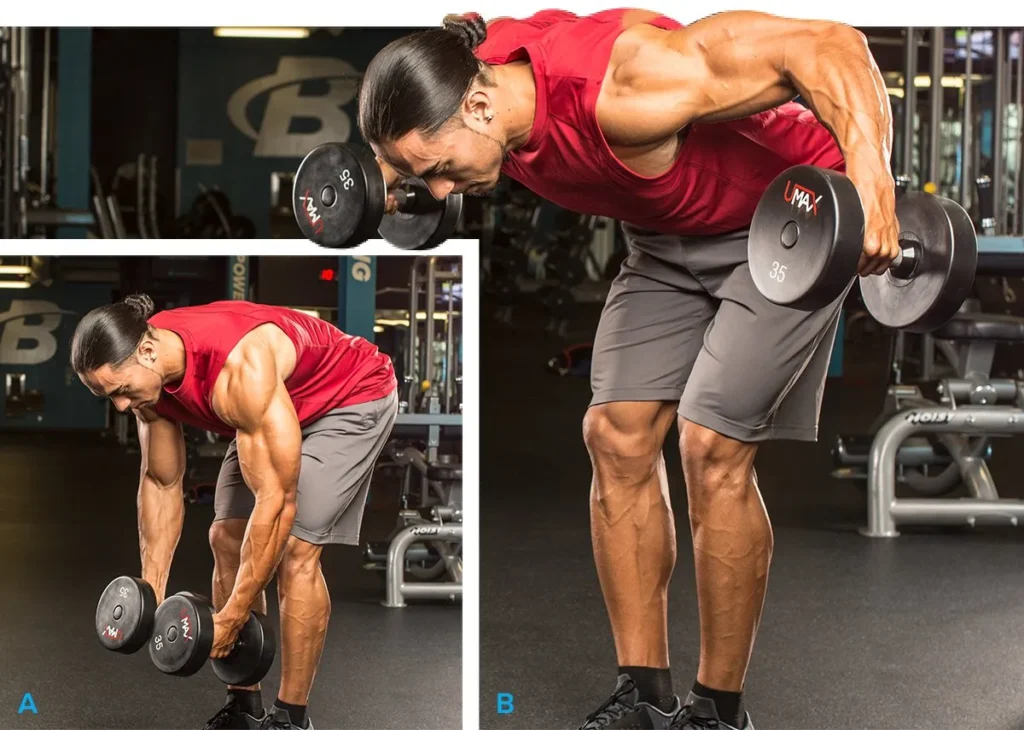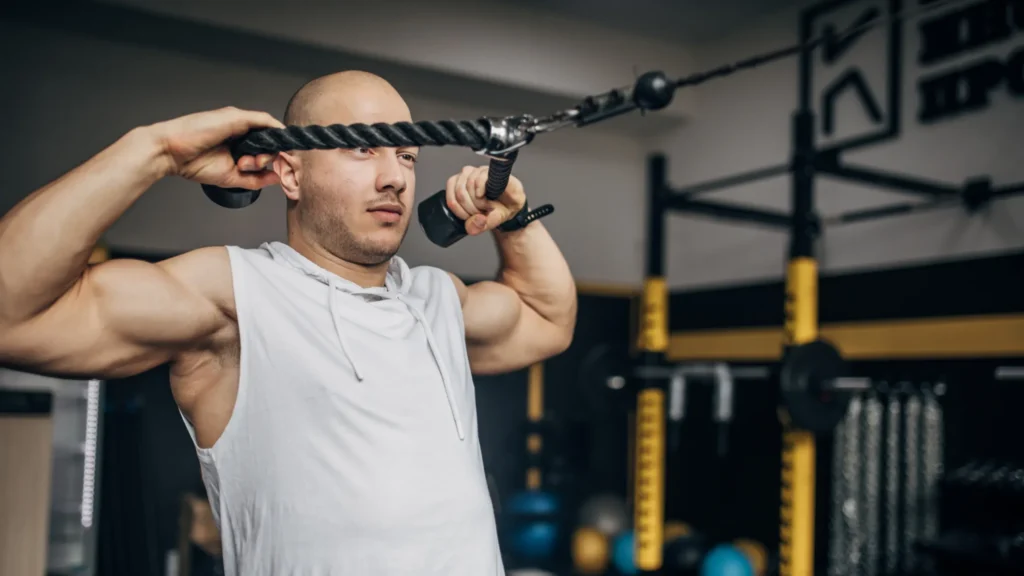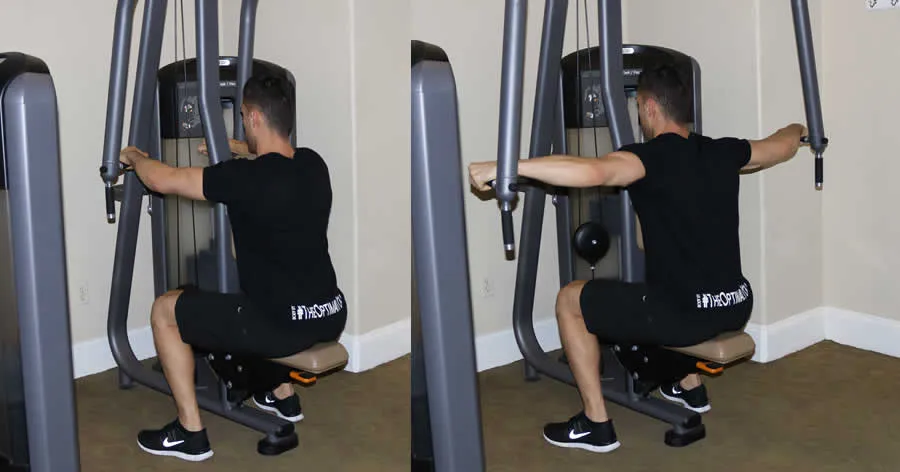Best Rear Delt Exercises for a Stronger, Balanced Shoulders:
When it comes to building strong, well-rounded shoulders, the rear delts (posterior deltoids) often don’t get the attention they deserve. While front and middle delts tend to hog the spotlight in most shoulder workouts, neglecting the rear delts can lead to imbalances, poor posture, and a lack of overall shoulder strength. Properly training your rear delts not only enhances the aesthetics of your shoulders but also contributes to better shoulder stability and injury prevention.
Top Rear Delt Exercises
Exercise 1: Rear Delt Fly

How to Perform the Rear Delt Fly
The Rear Delt Fly is a staple in any shoulder workout and can be performed with dumbbells or cables. Stand or sit with a slight bend in your knees, holding a dumbbell in each hand. Lean forward at the hips, keeping your back straight, and let your arms hang down. From this position, raise the dumbbells out to the sides, focusing on squeezing your shoulder blades together. Lower the weights back down slowly and repeat.
Benefits of Rear Delt Fly
This exercise directly targets the rear delts and helps in building strength and muscle mass in the back of the shoulders. It’s also great for improving posture by balancing out the muscles in the shoulder girdle.
Exercise 2: Face Pulls

How to Perform Face Pulls
Face Pulls are performed using a cable machine with a rope attachment. Set the pulley at about head height, grab the rope with an overhand grip, and step back until your arms are fully extended. Pull the rope towards your face, focusing on bringing your hands apart as you pull. Keep your elbows high and squeeze your rear delts at the peak of the movement before slowly returning to the start position.
Benefits of Face Pulls
Face Pulls are excellent for targeting the rear delts while also engaging the upper traps and rotator cuff muscles. This makes them not only a rear delt builder but also a shoulder health exercise, helping to prevent injuries and improve overall shoulder stability.
Exercise 3: Reverse Pec Deck Machine

How to Perform the Reverse Pec Deck Machine
The Reverse Pec Deck Machine is a go-to for isolating the rear delts. Sit on the machine facing the pads, and set the handles to the appropriate width. With your arms slightly bent, push the handles backward in an arc motion, focusing on squeezing your rear delts. Slowly return to the starting position and repeat.
Benefits of the Reverse Pec Deck Machine
This machine allows for strict isolation of the rear delts, making it perfect for beginners or those looking to really hone in on this muscle group without the risk of other muscles taking over.
Exercise 4: Bent-Over Dumbbell Rows

How to Perform Bent-Over Dumbbell Rows
To perform Bent-Over Dumbbell Rows, hold a dumbbell in each hand with a neutral grip. Bend your knees slightly and lean forward at the hips until your torso is almost parallel to the floor. From this position, row the dumbbells towards your hips, focusing on squeezing your shoulder blades together at the top of the movement. Lower the dumbbells slowly and repeat.
Benefits of Bent-Over Dumbbell Rows
This exercise not only targets the rear delts but also works the lats and traps, making it a great compound movement for overall upper body development. It’s particularly effective for those looking to build both size and strength.
Exercise 5: Cable Reverse Fly

How to Perform Cable Reverse Fly
The Cable Reverse Fly is performed using a cable machine set at a low or mid-height. Stand between the cables, cross your hands to grab the opposite cable handles, and step back until there’s tension in the cables. With a slight bend in your arms, pull the cables outward in a wide arc, focusing on your rear delts. Slowly return to the starting position and repeat.
Benefits of Cable Reverse Fly
This exercise provides constant tension throughout the movement, which can lead to better muscle activation and growth. It also allows for a greater range of motion, making it an excellent choice for fully engaging the rear delts.
Exercise 6: T-Bar Rows

How to Perform T-Bar Rows
To perform T-Bar Rows, load the bar with weight and straddle it, gripping the handle with both hands. Keeping your back flat, bend at the hips until your torso is at about a 45-degree angle. Row the bar towards your chest, focusing on squeezing your shoulder blades together at the top. Lower the bar slowly and repeat.
Benefits of T-Bar Rows
T-Bar Rows are a powerful compound movement that targets the rear delts along with the upper back and lats. This exercise is great for building both size and strength and is a fantastic addition to any back or shoulder routine.
Exercise 7: Rear Delt Barbell Rows

How to Perform Rear Delt Barbell Rows
For Rear Delt Barbell Rows, use a barbell with a pronated (overhand) grip. Bend your knees slightly and lean forward at the hips, keeping your back straight. Row the barbell towards your lower chest or upper abdomen, focusing on squeezing your shoulder blades together and engaging your rear delts. Lower the barbell slowly and repeat.
Benefits of Rear Delt Barbell Rows
This variation of the row specifically targets the rear delts, helping to build thickness and strength in the back of the shoulders. It also works the upper traps and rhomboids, making it an effective exercise for overall upper back development.
Tips for Effective Rear Delt Training
Proper Form and Technique
Maintaining proper form is key to effectively targeting the rear delts. Avoid using momentum or allowing other muscles, like the traps, to take over the movement. Focus on slow, controlled reps and really squeeze the rear delts at the top of each exercise.
Frequency and Volume
Rear delts can be trained 2-3 times per week, either on their own or as part of a larger shoulder or back workout. Aim for 3-4 sets of 8-12 reps per exercise, adjusting the volume based on your overall workout routine.
Incorporating Rear Delt Exercises into Your Routine
It’s important to include rear delt exercises in your routine to ensure balanced shoulder development. They can be added to your shoulder day, back day, or even as a standalone session, depending on your goals and training split.
Common Mistakes and How to Avoid Them
Overtraining the Front Delts
Many people overemphasize front delt exercises like presses and raises, which can lead to imbalances and shoulder issues. Ensure you’re giving equal attention to your rear delts to maintain balance.
Neglecting the Rear Delts
The rear delts are often overlooked in favor of more visible muscles. Make a conscious effort to include dedicated rear delt exercises in your routine to avoid underdevelopment.
Using Too Much Weight
Lifting too heavy can compromise form and shift the focus away from the rear delts. Start with a lighter weight that allows you to perform the exercises with proper form and gradually increase as you get stronger.
Conclusion
Training your rear delts is crucial for building strong, balanced shoulders and preventing injuries. By incorporating these exercises into your routine and focusing on proper form, you can effectively target this often-neglected muscle group and see significant improvements in your shoulder strength and overall physique.
Also Read :
- Understanding the Monkeypox Outbreak: Key Insights & Tips
- 15 Tasty High-Protein, Low-Carb Recipes for Healthy Eating
- Overcome Maladaptive Daydreaming with Mindful Meditation
- Ultimate Keto Diet Plan: Simple Steps for Effective Results
- Release Trauma with Somatic Exercises Today!
- Discover Somatic Exercises for Effective Weight Loss
- Strengthen Your Lower Back with These Gym Equipment
FAQ’S:
What is the best exercise for targeting the rear delts?
The Rear Delt Fly is one of the best exercises for targeting the rear delts, providing isolation and effective muscle engagement.
How often should I train my rear delts?
You can train your rear delts 2-3 times per week, depending on your overall workout routine and recovery ability.
Can I train rear delts on the same day as back or shoulder workouts?
Yes, rear delts can be trained on the same day as back or shoulder workouts, as they often assist in pulling movements.
What are the signs of weak rear delts?
Signs of weak rear delts include poor posture, shoulder imbalances, and difficulty in pulling exercises.
